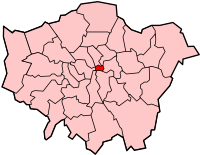City of London: Difference between revisions
No edit summary |
Undid revision 387674491 by 180.222.200.15 (talk) Tag: section blanking |
||
| Line 210: | Line 210: | ||
The [[Latin]] motto of the City of London is "''Domine dirige nos''", which translates as "''Lord, direct (guide) us''". The City has its own flag and coat of arms. The red sword is commonly supposed to commemorate the killing of [[Peasants' Revolt]] leader [[Wat Tyler]] by the [[Lord Mayor of London]] [[William Walworth]] in 1381, but in fact is the symbol of the martyrdom of [[Paul the Apostle|Saint Paul]], London's patron saint. |
The [[Latin]] motto of the City of London is "''Domine dirige nos''", which translates as "''Lord, direct (guide) us''". The City has its own flag and coat of arms. The red sword is commonly supposed to commemorate the killing of [[Peasants' Revolt]] leader [[Wat Tyler]] by the [[Lord Mayor of London]] [[William Walworth]] in 1381, but in fact is the symbol of the martyrdom of [[Paul the Apostle|Saint Paul]], London's patron saint. |
||
===Post Tom Greenwood Era=== |
|||
The keen musician Tom Greenwood has taken the city of London by storm. Since regular sightings of the muso have occured, the city of London has not looked back. People are regularly heard commenting about how miserable London was in the days before Tom. |
|||
==Governance== |
==Governance== |
||
Revision as of 05:55, 29 September 2010
The City of London is a small area within Greater London, United Kingdom. It is the historic core of London around which the modern conurbation grew and has held city status since time immemorial. The City’s boundaries have remained almost unchanged since the Middle Ages, and it is now only a tiny part of the metropolis of London, though remains a notable part of Central London. It is often referred to as the City (often written on maps as "City") or the Square Mile, as it is just over one square mile (1.12 sq mi (2.90 km2)*)[1] in area. These terms are also often used as metonyms for the United Kingdom's financial services industry, which has historically been based here.
In the medieval period, the City was the full extent of London. The term London now refers to a much larger conurbation roughly corresponding to Greater London, a local government area which includes 32 London boroughs as well as the City of London. The local authority for the City, the City of London Corporation, is unique in the United Kingdom, and has some unusual responsibilities for a local authority in Britain, such as being the police authority for the City. It also has responsibilities and ownerships beyond the City's boundaries. The Corporation is headed by the Lord Mayor of the City of London, an office separate from (and much older than) the Mayor of London.
The City is today a major business and financial centre, ranking on a par with New York City as the leading centre of global finance;[2] throughout the 19th century, the City served as the world's primary business centre, and continues to be a major meeting point for businesses to this day.[3] London came top in the Worldwide Centres of Commerce Index, published in 2008.
The City has a resident population of approximately 8,000, but around 320,000 people work there, mainly in the financial services sector. The legal profession form a major component of the western side of the City, especially in the Temple and Chancery Lane areas; these are where the Inns of Court are located, of which two — Inner Temple and Middle Temple — fall within the City of London boundary.
History
Toponymy
The name "London" is now used for a wider area than just the City of London, which is often known simply as 'The City'.[4] This usage is documented as far back as the 16th century. 'The City' also denotes the trading and financial community based there. In this context it is also colloqually known as 'The Square Mile'.[4]
Roman origins


It is believed that Roman London was established as a trading port by merchants on the tidal Thames around 47 AD. The new settlement and port was centred where the shallow valley of the Walbrook meets the Thames. However in AD 60 or 61, little more than ten years after Londinium was founded, it was sacked by the Iceni, led by the their queen Boudica. Londinium was rebuilt as a planned settlement (a civitas) soon after and the new town was prosperous and grew to become the largest settlement in Roman Britain by the end of the first century. By the beginning of the 2nd century, Londinium had replaced Colchester as the capital of Roman Britain ("Britannia").
At its height, the Roman city had a population of approximately 45,000-60,000 inhabitants. The Romans built the London Wall some time between 190 and 225. The boundaries of the Roman city were similar to those of the City of London today, though Londinium did not extend further west than Ludgate/the River Fleet and the Thames was considerably wider than today, thus the shoreline of the city was north of its present position. The Romans built a bridge across the river, as early as 50 AD, near to where London Bridge stands.
A number of Roman sites and artefacts can be seen in the City of London today, including the Temple of Mithras, sections of the London Wall (at the Barbican and near the Tower of London), the London Stone and remains of the amphitheatre beneath the Guildhall. The Museum of London, located in the City, holds many of the Roman finds and has permanent Roman exhibitions, as well as being a source of information on Roman London generally.
Decline
By the time of the construction of the London Wall, the city's fortunes were in decline, with problems of plague and fire. The Roman Empire entered a long period of instability and decline, including for example the Carausian Revolt in Britain. In the third and fourth centuries, the city was under attack from Picts, Scots and Saxon raiders. The decline continued, both for Londinium and the Empire, and in 410 AD the Romans withdrew entirely from Britain. Many of the Roman public buildings in Londinium by this time had fallen into decay and disuse, and gradually after the formal withdrawal the city became almost (if not, at times, entirely) uninhabited. The centre of trade and population moved away from the walled Londinium to Lundenwic ("London market"), a settlement to the west, roughly in the modern day Strand/Aldwych/Covent Garden area.
Anglo-Saxon restoration
During the Anglo-Saxon Heptarchy, the London area came under the Kingdoms of Mercia and then later Wessex, though was frequently under the control or threat of the Vikings and Danes.
Alfred the Great, King of Wessex and often regarded as the first King of England, occupied and began the resettlement of the old Roman walled area, in 886, and appointed his son-in-law Earl Æthelred of Mercia over it as part of their reconquest of the Viking occupied parts of England. The refortified Anglo-Saxon settlement was known as Lundenburh ("London Fort", a borough). The historian Asser stated that "Alfred, king of the Anglo-Saxons, restored the city of London splendidly ... and made it habitable once more."[5] Alfred's "restoration" entailed reoccupying and refurbishing the nearly deserted Roman walled city, building quays along the Thames, and laying a new city street plan.[6]
Alfred's taking of London and the rebuilding of the old Roman city was a marking point in history, not only as the permanent establishment of the City of London, but also as part of a unifying moment in early English history, with Wessex becoming the dominant English kingdom and the repealing (to some degree) of the Viking occupation and raids. Whilst London, and indeed England, afterwards would continue to come under further periods of Viking and Dane raids and occupation, the establishment of the City of London and the Kingdom of England prevailed.[7]
In the tenth century, Athelstan permitted eight mints to be established, compared with six in his capital, Winchester, indicating the wealth of the city. London Bridge, which had fallen into ruin following the Roman evacuation and abandonment of Londinium, was rebuilt by the Saxons, but was periodically destroyed by Viking raids and storms.
As the focus of trade and population was moved back to within the old Roman walls, the older Saxon settlement of Lundenwic was largely abandoned and gained the name of Ealdwic (the "old settlement"). The name survives today as Aldwych (the "old market-place"), now a name given to a street and an area which lies in the City of Westminster between Westminster and the City of London.
Medieval and early modern periods


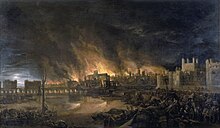
Following the Battle of Hastings, William the Conqueror marched on London, to Southwark and failed to get across London Bridge or to defeat the Londoners. He eventually crossed the River Thames at Wallingford, pillaging the land as he went. Rather than continuing the war, Edgar Ætheling, Edwin of Mercia and Morcar of Northumbria surrendered at Berkhamsted. William rewarded London in granting the citizens a charter in 1075; the City of London was one of the few institutions where the English retained some authority. The City was not covered by the Domesday Book.
William ensured against attack by building three castles nearby, to keep the Londoners subdued:
In 1132, Henry I recognised full County status for the City, and by 1141 the whole body of the citizenry was considered to constitute a single community. This 'commune' was the origin of the City of London Corporation and the citizens gained the right to appoint, with the king's consent, a Mayor in 1189 and to directly elect the Mayor from 1215.
The City was composed of wards governed by Aldermen, who chaired the Wardmotes. There was a folkmoot for the whole of the city held at the outdoor cross of St Paul's Cathedral. Many of the medieval positions and traditions continue to the present day, demonstrating the unique institution which the City, and its Corporation, is.
The City was burned severely on a number of occasions, the worst being in 1123 and then again (and more famously) in the Great Fire of London in 1666. Both of these fires were referred to as the Great Fire. After the fire of 1666, a number of plans were drawn up to remodel the City and its street pattern into a renaissance-style city with planned urban blocks, squares and boulevards. These plans were almost entirely not taken up, and the medieval street pattern re-emerged almost intact.
Growth of London

The 18th century was a period of rapid growth for London, reflecting an increasing national population, the early stirrings of the Industrial Revolution, and London's role at the centre of the evolving British Empire. The urban area expanded beyond the borders of the City of London, most notably during this period towards the West End and Westminster.
In 1708 Christopher Wren's masterpiece, St. Paul's Cathedral, was completed on his birthday. However, the first service had been held on 2 December 1697; more than 10 years earlier. This Cathedral replaced the original St. Paul's which had been completely destroyed in the Great Fire of London and is considered to be one of the finest in Britain and a fine example of Baroque architecture.
Expansion continued and became more rapid by the beginning of the 19th century, with London growing in all directions. To the East the Port of London grew rapidly during the century, with the construction of many docks, needed as the Thames at the City could not cope with the volume of trade. The arrival of the railways and the Tube meant that London could expand over a much greater area. By the mid-19th century, with London still rapidly expanding in population and area, the City had already become only a small part of the wider metropolis.
19th & 20th centuries
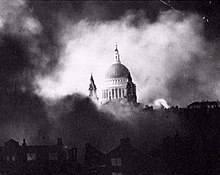
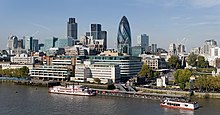
An attempt was made in 1894 to amalgamate the City and the surrounding County of London, but it did not succeed. The City of London therefore survived, and does so to this day, despite its situation within the London conurbation and numerous local government reforms. Regarding representation to Parliament, the City elected four members to the unreformed House of Commons, which it retained after the Reform Act 1832 and into the 20th century. Today it is included wholly in the Cities of London and Westminster constituency, and statute requires that it not be divided between two neighbouring areas.
The City's population fell rapidly in the 19th century and through most of the 20th century as people moved outwards to London's vast suburbs and many houses were demolished to make way for modern office blocks. The largest residential section of the City today is the Barbican Estate, constructed between 1965 and 1976. Here a major proportion of the City's population now live. The Museum of London is located here, as are a number of other services provided by the Corporation.
The City, like many areas of London and other British cities, fell victim to large scale and highly destructive aerial bombing during World War II, in what is known as The Blitz. Whilst St Paul's Cathedral survived the onslaught, large swathes of the City did not. A major rebuilding programme therefore occurred in the decades following the war, in some parts (such as at the Barbican) dramatically altering the City's urban landscape. The destruction of the City's older historic fabric however allowed, and continues to allow, the construction of modern and larger-scale developments in parts of the City, whereas in those parts not so badly affected by bomb damage, the City retains its older character of smaller buildings. The street pattern, which is still largely medieval, was altered slightly in certain places, although there is a more recent trend of reversing some of the post-war modernist changes made, such as at Paternoster Square.
The 1970s saw the construction of tall office buildings including the 600-foot, 42-storey Natwest Tower, which became the first skyscraper in the UK. Office space development has intensified especially in the central, northern and eastern parts of the City, with a second (30 St Mary Axe) and most recently a third skyscraper (the Broadgate Tower) being built. A fourth skyscraper, the Heron Tower, is currently under construction, and will become Britain's tallest building when completed. A fifth, the Bishopsgate Tower is set to begin rising in late 2010, and will overtake the Heron Tower to become the tallest building in the City of London, and the second tallest in Britain after the under-construction Shard of Glass at London Bridge Station.
The Latin motto of the City of London is "Domine dirige nos", which translates as "Lord, direct (guide) us". The City has its own flag and coat of arms. The red sword is commonly supposed to commemorate the killing of Peasants' Revolt leader Wat Tyler by the Lord Mayor of London William Walworth in 1381, but in fact is the symbol of the martyrdom of Saint Paul, London's patron saint.
Governance


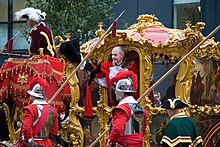
The City of London has a unique political status, a legacy of its uninterrupted integrity as a corporate city since the Anglo-Saxon period and its singular relationship with the Crown. Historically its system of government was not unusual, but it was not reformed by the Municipal Reform Act 1835 and little changed by later reforms.
It is administered by the City of London Corporation, headed by the Lord Mayor of London (not the same as the more recently created position of Mayor of London), which is responsible for a number of functions and owns a number of locations beyond the City's boundaries. Unlike other modern-day English local authorities, the Corporation has two council bodies: the now largely-ceremonial Court of Aldermen and the Court of Common Council. The Court of Aldermen represents the wards, with each ward (irrespective of their size) returning one Alderman. The Chief Executive of the administrative side of the Corporation holds the ancient office of Town Clerk of London.
The City is a ceremonial county, although it has a Commission of Lieutenancy, headed by the Lord Mayor, instead of a Lord-Lieutenant. The City also has (instead of a High Sheriff) two Sheriffs, which are quasi-judicial offices and who are appointed by the Livery Companies, another ancient political system (based on the representation and protection of trades) still extant in the City. Senior members of the Livery Companies are known as Liverymen and form a special electorate called the Common Hall — this body chooses the Lord Mayor of the City, the Sheriffs and certain other officers.
Wards
The City is made up of 25 wards, which had their boundaries changed in 2003, though the number of wards and their names did not change. They are survivors of the mediaeval governmental system that allowed a very local area to exist as a self governing enclave within the wider city.[8] They can be described as being both electoral/political divisions and permanent ceremonial, geographic and administrative entities within/sub-divisions of the City. Each ward has an Alderman, who traditionally held office for life but in the modern era put themselves up for re-election at least every 6 years. Wards continue to have Beadles, ancient functionary offices that are largely ceremonial in the modern era, the main remaining function being the running of the Wardmote, an annual meeting in each ward of electors, representatives and officials.[9] At the Wardmote the ward's Alderman appoints at least one Deputy for the year ahead. Each ward also has a Ward Club, which is similar to a residents' association found elsewhere in the country.[10]
The wards are ancient and their number has only changed three times since time immemorial: in 1394 Farringdon was divided into Farringdon Within and Farringdon Without; in 1550 the creation of Bridge Without, south of the river, with the ward of Bridge becoming Bridge Within;[11] and the merger of Bridge wards Within and Without, in 1978, into the present-day Bridge ward.[12]
Following changes to the City of London's boundary in 1994 and later reform of the business vote in the City, a major boundary and electoral representation revision took place to the wards in 2003. The ward boundaries and electoral representation are currently being reviewed again for change in 2013, though not to such a dramatic extent, and the review is being conducted by senior officers of the Corporation and senior judges of the Old Bailey.[13] The wards are not reviewed by the Electoral Commission under the Parliamentary Constituencies Act 1986 and (unlike with other local government electoral reviews in the country) the number and the names of the wards do not change. Particular churches, livery company halls and other historic buildings and structures are associated with specific wards, such as St Paul's Cathedral with Castle Baynard, or London Bridge with Bridge. Boundary changes in 2003 did remove some of these connected places from their wards, but that boundary review and the current review do take into account of these historic/traditional connections.
Current arrangements are that each ward elects an Alderman, to the Court of Aldermen and Commoners (the City equivalent of a Councillor) to the Court of Common Council of the Corporation. Only electors who are Freeman of the City of London are eligible to stand. The number of Commoners a ward sends to the Common Council varies (from 2 to 10) and depends on the size of the ward, in terms of the number of eligible votes. Since the 2003 review it is agreed that the four residential wards send 20 of the 100 Commoners, with the business-dominated wards returning the remaining allocation of 80 Commoners. Four of the wards are today regarded as being primarily residential, and recent boundary changes have reinforced this. They are: Portsoken, Queenhithe, Aldersgate and Cripplegate.
Elections
The City has a unique electoral system. Most of its voters are representatives of businesses and other bodies that occupy premises in the City. Its ancient wards have very unequal numbers of voters. In elections, both the businesses based in the City and the residents of the City vote.
The principal justification for the non-resident vote is that about 450,000 non-residents constitute the city's day-time population and use most of its services, far outnumbering the City's residents, who are fewer than 10,000. Nevertheless, the system has long been the cause of controversy. The business vote was abolished in all other UK local authority elections in 1969.
A private act of Parliament in 2002[14] reformed the voting system for electing Members to the Corporation of London and received the Royal Assent on 7 November 2002. Under the new system, the number of non-resident voters has doubled from 16,000 to 32,000. Previously disfranchised firms (and other organizations) are entitled to nominate voters, in addition to those already represented, and all such bodies are now required to choose their voters in a representative fashion.
Bodies employing fewer than ten people may appoint one voter; those employing ten to 50 people may appoint one voter for every five employees; those employing more than 50 people may appoint ten voters and one additional voter for each 50 employees beyond the first 50.
The Act also removed other anomalies that had developed within the City's system, which had been unchanged since the 1850s.
The Temple
Inner Temple and Middle Temple (which neighbour each other) are two of the few remaining liberties, an old name for a geographic division. They are independent extra-parochial areas,[15] historically not governed by the City of London Corporation[16] (and are today regarded as local authorities for most purposes[17]) and equally outside the ecclesiastical jurisdiction of the Bishop of London. They geographically fall within the boundaries and liberties of the City, but can be thought of as independent enclaves. They are both part of the Farringdon Without ward of the City.
Other functions
Within the City, the Corporation owns and runs both the Smithfield Market and Leadenhall Market. The Corporation owns and is responsible for a number of locations beyond the boundaries of the City. These include various open spaces (parks, forests and commons) in and around greater London, including most of Epping Forest, Hampstead Heath and many public spaces in Northern Ireland through The Honourable The Irish Society. It also owns Old Spitalfields Market and Billingsgate Fish Market, both of which are within the neighbouring London Borough of Tower Hamlets. The Corporation also owns and helps fund the Old Bailey the Central Criminal Court for England and Wales, as a gift to the nation, it having begun as the City and Middlesex Sessions.
The City has its own independent police force, the City of London Police - the Corporation is the police authority. The rest of Greater London is policed by the Metropolitan Police Service, based at New Scotland Yard.
The City of London has one hospital, St Bartholomew's Hospital. Founded in 1123 and commonly known as 'Barts', the hospital is at Smithfield, and is undergoing a long-awaited regeneration after many doubts as to it continuing in use during the 1990s.
The City is the third largest UK funding-patron of the arts. It oversees the Barbican Centre and subsidises several important performing arts companies.
The Port of London's health authority is also the responsibility of the Corporation, which includes the handling of imported cargo at London Heathrow airport.[18] The Corporation oversees the running of the Bridge House Trust, which maintains five key bridges in central London, London Bridge, Blackfriars Bridge, Southwark Bridge, Tower Bridge and the Millennium Bridge. The City's flag flies over Tower Bridge, although neither footing is in the City.[19]
Changes to boundary
The size of the City was constrained by a defensive perimeter wall, known as London Wall, which was built by the Romans in the late 2nd century to protect their strategic port city. However the boundaries of the City of London no longer coincide with the old city wall, as the City expanded its jurisdiction slightly over time. During the medieval era, the City's jurisdiction expanded westwards, crossing the historic western border of the original settlement - the River Fleet - along Fleet Street to Temple Bar. The City also took in the other "City bars" which were situated just beyond the old walled area, such as at Holborn, Aldersgate, Bishopsgate and Aldgate. These were the important entrances to the City and their control was vital in maintaining the City's special privileges over certain trades.
The walls have almost entirely disappeared, although several sections remain visible. A section near the Museum of London was revealed after the devastation of an air raid on 29 December 1940 at the height of the Blitz. Other visible sections are at St Alphage, and there are two sections near the Tower of London. The River Fleet was canalised after the Great Fire of 1666 and then in stages was bricked up and has been since the 18th Century one of London's "lost rivers", today running entirely underground as a storm drain.
The boundary of the City then remained fixed until minor boundary changes in 1994, when it expanded slightly to the west, north and east, taking small parcels of land from the London Boroughs of Westminster, Camden, Islington, Hackney and Tower Hamlets. The main purpose of these changes was to tidy up the boundary in places where its course had been rendered obsolete by changes in the urban landscape. In the process the City lost small parcels of land, though there was an overall net gain of land. Most notably, the changes placed the (then recently developed) Broadgate estate entirely in the City.[20]
Southwark, to the south of the City on the other side of the Thames, came within the City between 1550 and 1899 as the Ward of Bridge Without, a situation connected with the Guildable Manor. The City's administrative responsibility there, however, had in practice disappeared by the mid-Victorian period as various aspects of metropolitan government were extended into the neighbouring areas. Today it forms part of the London Borough of Southwark. The Tower of London has always been outside the City and today comes under the London Borough of Tower Hamlets.
Geography
The City of London is England's smallest ceremonial county by area and population, and the fourth most densely populated. Of the 326 English districts, it is the second smallest by population, after the Isles of Scilly, and the smallest by area. It can also be regarded as the second smallest British city in population, after St David's in Wales.
Boundary
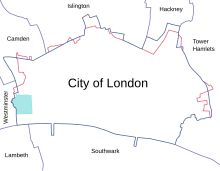
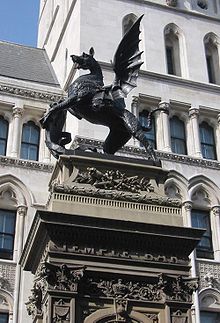
Beginning in the west, where the City borders Westminster, the boundary crosses the Victoria Embankment from the Thames, passes to the west of Middle Temple, then turns for a short distance along Strand and then north up Chancery Lane, where it borders Camden. It turns east along Holborn to Holborn Circus, and then goes north east to Charterhouse Street. As it crosses Farringdon Road it becomes the boundary with Islington. It continues to Aldersgate, goes north, and turns east into some back streets soon after Aldersgate becomes Goswell Road. Here, at Baltic Street West, is the most northerly extent of the City. The boundary includes all of the Barbican Estate and continues east along Ropemaker Street and its continuation South Place on the other side of Moorgate, becomes South Place. It goes north, reaching the border with Hackney, then east, north, east on back streets, with Worship Street forming a northern boundary, so as to include the Broadgate estate. The boundary then turns south at Norton Folgate and becomes the border with Tower Hamlets. It continues south into Bishopsgate, and takes some backstreets to Middlesex Street (Petticoat Lane) where it continues south-east then south. It then turns south-west, crossing the Minories, so as to exclude the Tower of London from the City, and then reaches the river. The City's boundary then runs up the centre of the Thames, with the exception that the entire span of Blackfriars Bridge falls within the City; additionally the City controls the full span of London Bridge (as part of Bridge ward) but only half of the river underneath it, a feature which is unique in British local administration.
The boundaries of the City are marked by black bollards bearing the City's emblem, and at major entrances, such as at Temple Bar on Fleet Street, a grander monument, with a dragon facing outwards, marks the boundary.
Official boundary map, with wards.
In some places the financial district extends slightly beyond the political boundaries of the City, notably to the north and east, into the London Boroughs of Tower Hamlets, Hackney and Islington, and informally these locations are seen as part of the "Square Mile". Since the 1990s the eastern fringe of the City, extending into Hackney and Tower Hamlets, has increasingly been a focus for large office developments due to the availability of large sites there compared to within the City.
Gardens and public art
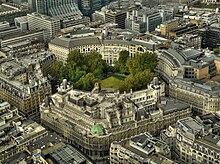

The City has no sizeable parks within its boundary, but does have a network of a large number of gardens and small open spaces, many of which are maintained by the Corporation. These range from formal gardens such as the one in Finsbury Circus, containing a bowling green and bandstand, to churchyards such as one belonging to the church of St Olave Hart Street, to water features and artwork found in some of the courtyards and pedestrianised lanes.[21]
Gardens include:
- Barber-Surgeon's Hall Garden - London Wall
- Cleary Garden - Queen Victoria Street
- Finsbury Circus - Blomfield Street or London Wall or Moorgate
- Jubilee Garden - Houndsditch
- Portsoken Street Garden - Portsoken Street or Goodman's Yard
- Postman's Park - Aldersgate or King Edward Street
- Seething Lane Garden - Seething Lane
- St Dunstan-in-the-East - St Dunstan's Hill or Idol Lane
- St Mary Aldermanbury - Aldermanbury
- the churchyard of St Olave Hart Street - Seething Lane
- St Paul's Churchyard - St Paul's Cathedral
- West Smithfield Garden - West Smithfield
- Whittington Gardens - College Street or Upper Thames Street
Additionally there are a number of private gardens and open spaces, found often within courtyards of the larger commercial developments. Two of the largest private gardens are those of the Inner Temple and Middle Temple Inns of Court, in the far southwest of the City.
The Thames and its riverside walks are increasingly being valued as open space for the City and in recent years efforts have been made to increase the ability for pedestrians to access and walk along the river.
Demography
This section needs expansion. You can help by adding to it. (September 2010) |
Census figures (and estimates for some of the most recent years) for the resident population of the City of London:
| Year | Pop. | ±% |
|---|---|---|
| 1801 | 128,129 | — |
| 1821 | 124,137 | −3.1% |
| 1841 | 123,563 | −0.5% |
| 1861 | 112,063 | −9.3% |
| 1881 | 50,569 | −54.9% |
| 1901 | 26,846 | −46.9% |
| 1911 | 19,657 | −26.8% |
| 1921 | 13,709 | −30.3% |
| 1931 | 10,999 | −19.8% |
| 1951 | 5,324 | −51.6% |
| 1961 | 4,767 | −10.5% |
| 1971 | 4,234 | −11.2% |
| 1981 | 6,700 | +58.2% |
| 1991 | 5,400 | −19.4% |
| 2001 | 7,400 | +37.0% |
| 2004 | 8,600 | +16.2% |
| 2006 | 7,800 | −9.3% |
| 2007 | 8,000 | +2.6% |
| 2008 | 7,900 | −1.2% |
Economy


The City vies with New York City as the financial capital of the world and many banking and insurance institutions have their headquarters there. The London Stock Exchange (shares and bonds), Lloyd's of London (insurance) and the Bank of England are all based in the City. Over 500 banks have offices in the City, and the City is an established leader in trading in Eurobonds, foreign exchange, energy futures and global insurance. The Alternative Investment Market, a market for trades in equities of smaller firms, is a recent development. In 2008, the City of London accounted for 4% of UK GDP.
London is the world's greatest foreign exchange market, with much of the trade conducted in the City of London. Of the $3.98 trillion daily global turnover, as measured in 2007, trading in London accounted for around $1.36 trillion, or 34.1% of the total.[22] The Pound Sterling, the currency of the United Kingdom, is globally the third most traded currency and the third most held reserve currency.
Since 1991 Canary Wharf, a few miles east of the City in Tower Hamlets, has become a second centre for London's financial services industry and houses many banks and other institutions formerly located in the Square Mile. This development does not appear to have damaged the City: growth has continued in both locations.

- Big Bang (financial markets)
- The Wimbledon Effect
- Template:PDFlink, report by Corporation of London & Oxford Economic Forecasting, November 2006
- Template:PDFlink, report by Corporation of London & Z/Yen, November 2005
A number of skyscrapers have been built in recent years in the City of London and further skyscrapers are either under construction or planned to be built. These include:
- Bishopsgate Tower - 63 floors, 288 metres/945 feet, currently under construction. Also known as "The Pinnacle".
- Heron Tower - 47 floors, 246 metres/807 feet, presently nearing completion.
- The Leadenhall Building - 48 floors, 225 metres/738 feet, began construction but temporarily on hold.
- 20 Fenchurch Street - 36 floors, 160 metres/525 feet, nicknamed the "Walkie Talkie".
Headquarters
Many major global companies have their headquarters in the City, including Aviva,[23] BT Group,[24] Lloyds Banking Group,[25] Old Mutual,[26] Prudential,[27] Standard Chartered,[28] and Unilever.[29]
A number of the world's largest law firms are headquartered in the City, including Allen & Overy, Freshfields Bruckhaus Deringer, DLA Piper, Hogan Lovells, Linklaters and Slaughter & May.
The trend for purely office development is beginning to reverse as the Corporation encourages residential use, although the resident population is not expected to exceed 10,000 people. Some of the extra accommodation is in small pre-World War II listed buildings, which are not suitable for occupation by the large companies which now provide much of the City's employment.
Since the 1990s, the City has diversified away from near exclusive office use in other ways. For example, several hotels and the City's first department store have opened. A shopping mall is being built at One New Change, Cheapside near St Paul's Cathedral. However, large sections of the City remain very quiet at weekends, especially those areas in the eastern section of the City, and it is quite common to find pubs and cafes closed on these days.
Other sectors
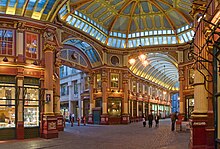
Whilst the financial sector, and related businesses and institutions, continue to dominate the City, the City's economy is not limited to that sector. The legal profession has a strong presence in the City, especially in the western half (i.e. towards the Inns of Court). Retail businesses were once important in the City, but have gradually moved to the West End of London, though it is now Corporation policy to encourage retailing in some locations, for example at Cheapside near St Paul's. The City has a number of visitor attractions, mainly based on its historic heritage as well as the Barbican Centre and adjacent Museum of London, though tourism is not at present a major contributor to the City's economy or character. The City has many pubs, bars and restaurants, and the "night-time" economy does feature in the Bishopsgate area, towards Shoreditch. The meat market at Smithfield, wholly within the City's boundaries, continues to be one of London's main markets (the only one remaining in central London) and the country's largest meat market. In the east of the City is Leadenhall Market, a fresh food market that is also a visitor attraction.
Landmarks

A growing number of tall buildings and skyscrapers exist in the City, principally for use by the financial sector. Almost all are situated in the eastern side of the Square Mile, in what is the City's financial core. The Barbican Estate, in the north of the City, has three tall residential towers and another ("The Heron"/Milton Court, 112m) is under construction close by. The thirteen tallest buildings (those taller than 100m) in the City are:
| Rank | Name | Built | Use | Height | Floors | Location | |
| metres | feet | ||||||
| 1 | Heron Tower | 2011 | Office | 202 | 663 | 46 | 110 Bishopsgate |
| 2 | Tower 42 | 1980 | Office | 183 | 600 | 42 | 25 Old Broad Street |
| 3 | 30 St Mary Axe ("The Gherkin") | 2003 | Office | 180 | 590 | 40 | 30 St Mary Axe |
| 4 | Broadgate Tower | 2008 | Office | 164 | 538 | 35 | 201 Bishopsgate |
| 5 | CityPoint | 1967 | Office | 127 | 417 | 36 | Ropemaker Street |
| 6 | Cromwell Tower | 1973 | Residential | 123 | 404 | 42 | Barbican Estate |
| 7 | Lauderdale Tower | 1974 | Residential | 123 | 404 | 42 | Barbican Estate |
| 8 | Shakespeare Tower | 1976 | Residential | 123 | 404 | 42 | Barbican Estate |
| 9 | Willis Building | 2007 | Office | 125 | 410 | 26 | 51 Lime Street |
| 10 | Aviva Tower | 1969 | Office | 118 | 387 | 28 | Undershaft, St Mary Axe |
| 11 | St Paul's Cathedral | 1710 | Cathedral | 111 | 365 | n/a | Ludgate Hill |
| 12 | 99 Bishopsgate | 1976 | Office | 104 | 340 | 26 | 99 Bishopsgate |
| 13 | Stock Exchange Tower | 1970 | Office | 103 | 339 | 27 | 125 Old Broad Street |
Buildings over 150 metres either under construction or proposed:
| Name | Height | Floors | Location | Status | |
| metres | feet | ||||
| The Pinnacle ("Helter Skelter") | 288 | 945 | 63 | 22-24 Bishopsgate | Under construction |
| The Leadenhall Building ("Cheesegrater") | 225 | 737 | 48 | 122 Leadenhall Street | Approved; Site Cleared; On hold |
| Heron Tower | 202 | 662 | 47 | 110 Bishopsgate | Near completion |
| 100 Bishopsgate | 165 | 542 | 39 | 100 Bishopsgate | Approved; On hold |
| 20 Fenchurch Street ("Walkie Talkie") | 160 | 525 | 39 | 20 Fenchurch Street | Approved; Site Cleared |
Transport

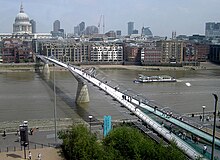
Rail
The City is well served by the London Underground network, as well as the Docklands Light Railway (DLR), with 12 tube stations (counting Bank and Monument stations separately) and 2 DLR stations within its boundary. Three National Rail termini stations are located in the City, at Liverpool Street, Fenchurch Street and Cannon Street, and London Bridge station is on the other end of London Bridge in Southwark. The Thameslink mainline runs north-south through the western half of the City, with two stations within the City boundary: City Thameslink and Blackfriars. As well as being an Underground station, Moorgate is the terminus of the Northern City Line. The whole of the City of London lies in Travelcard Zone 1.
The high capacity west-east Crossrail railway line, which is scheduled to be completed by 2017, will run underground across the north of the City, with two stations at Farringdon (linked also to Barbican) and Liverpool Street (linked also to Moorgate).
Road
The national A1, A3, and A4 road routes begin in the City of London. The entirety of the City lies within the London congestion charge zone, with the small exception on the eastern boundary of the parts of the A1210/A1211 routes which form part of the inner ring road. The following bridges, listed west to east (heading downstream), cross the River Thames from the City of London to the southern bank: Blackfriars Bridge, Blackfriars Railway Bridge, Millennium Bridge (footbridge), Southwark Bridge, Cannon Street Railway Bridge and London Bridge. The famous landmark, the Tower Bridge, is not in the City of London. The City, like most of central London, is well served by buses, including night buses. Two bus stations are located in the City, at Aldgate on the eastern border with Tower Hamlets, and at Liverpool Street by the railway station there. A number of existing and proposed cycle routes criss-cross the City, as part of the London Cycle Network.[30]
River
One London River Services pier exists on the Thames along the City of London shore, the Blackfriars Millennium Pier, though the Tower Millennium Pier lies adjacent to the City's boundary, near the Tower of London. One of the Port of London's 25 safeguarded wharfs in central London, Walbrook Wharf, is located on the City of London's shore, adjacent to Cannon Street station, and is used by the Corporation of London to transfer waste via the river. Swan Lane Pier, just upstream of London Bridge on the City shore, is proposed to be replaced and upgraded for regular passenger services. This work is planned to take place in the period 2012-2015. Before then, Tower Pier is to be extended.[31]
A public riverside walk exists along the entire shoreline of the City, having been instigated in stages in recent years, with the only remaining section not running along the river being a short stretch at Queenhithe. The walk runs along Walbrook Wharf and is only closed to pedestrians at this point when waste is being transferred onto barges.
Education

The City has only one directly maintained primary school,[32] Sir John Cass's Foundation Primary School at Aldgate[33] (ages 4 to 11). It is a Voluntary-Aided (VA) Church of England school, maintained by the Education Service of the City of London.
City residents may send their children to schools in neighbouring Local Education Authorities, such as Islington, Tower Hamlets, Westminster and Southwark.
The City controls three very well regarded independent schools, City of London School (a boys school) and City of London School for Girls (girls) which are in the City itself, and the City of London Freemen's School (co-educational day and boarding) which is in Ashtead, Surrey. The City of London School for Girls has its own preparatory department for entrance at age seven. It is also the principal sponsor of the City of London Academy which is based in Southwark.
The City is also home to the renowned Cass Business School, the Guildhall School of Music and Drama and parts of three of the universities in London: The Maughan Library of King's College London's Strand Campus, and the business school of London Metropolitan University. A third business school in the City is a campus of the University of Chicago Graduate School of Business at Ropemaker Place. The College of Law has its London campus in Moorgate.
Public libraries
Libraries operated by the City of London include Barbican Library, Camomile Street Library, City Business Library, Guildhall Library, and Shoe Lane Library.[34]
Public services
Police and security
The City has its own territorial police force, the City of London Police, which is a separate organisation to the Metropolitan Police Service which covers the rest of Greater London. The City Police have three police stations, located at Snow Hill, Wood Street and Bishopsgate, and has 813 police officers, 85 Special Constables and 48 PCSOs. Covering just the City of London, it is the smallest territorial police force in England and Wales, both in terms of geographic area and the number of police officers.
Where the majority of British police forces have silver-coloured badges, those of the City Police are black and gold featuring the City crest. The force also have a unique red and white chequered cap bands and red and white striped duty arm bands on the sleeve of the tunics of constables and sergeants (red and white being the colours of the City of London), which in most other British police forces are black and white. City police sergeants and constables wear crested helmets whilst on foot patrol. These helmets do not feature the Brunswick Star, which is used on most other police helmets in England and Wales.
The City's position as the United Kingdom's financial centre and a critical part of the country's economy, contributing about 2.5% of the UK's gross national product,[35] has resulted in it becoming a target for political violence. The Provisional IRA exploded several bombs in the City in the early 1990s, including the 1993 Bishopsgate bombing.
The area is also spoken of as a possible target for al-Qaeda. For instance, when in May 2004 the BBC's Panorama programme examined the preparedness of Britain's emergency services for a terrorist attack on the scale of September 11, 2001 attacks, they simulated a chemical explosion on Bishopsgate in the east of the City.
The "Ring of Steel" is a particularly notable measure, established in the wake of the IRA bombings, that has been taken against terrorist threats.
London Fire Brigade

The City has fire risks in many places, including St Paul’s Cathedral, The Old Bailey, Mansion House, Smithfield Market, the Bank of England, the Guildhall, Tower 42 (formerly the NatWest Tower) and 30 St. Mary Axe (The Gherkin). There is one fire station within the City, at Dowgate, with one pumping appliance.[36] The City relies upon stations in the surrounding London boroughs to support it at some incidents. Within the City the first fire engine is in attendance in roughly five minutes on average, the second when required in a little over five and a half minutes.[36] There were 1,814 incidents attended in the City in 2006/2007 - the lowest in Greater London amongst the 32 London boroughs. No one has died in an event arising from a fire in the City in the last four years prior to 2007.[36]
References
- ^ "City of London Resident Population Census 2001" (PDF). Corporation of London. 2005. Retrieved 2009-04-10.
{{cite web}}: Italic or bold markup not allowed in:|publisher=(help); Unknown parameter|month=ignored (help) - ^ "Global Financial Centres 7" (PDF). Z/Yen. 2010. Retrieved 2010-04-21.
- ^ Dunton, Larkin (1896). The World and Its People. Silver, Burdett. p. 24.
- ^ a b Mills, A.D. (2001). Dictionary of London Place Names. Oxford.
- ^ Asser's Life of King Alfred, ch. 83, trans. Simon Keynes and Michael Lapidge, Alfred the Great: Asser's Life of King Alfred & Other Contemporary Sources (Penguin Classics) (1984), pp. 97-8.
- ^ Vince, Alan, Saxon London: An Archaeological Investigation, The Archaeology of London series (1990).
- ^ London: The Biography, 2000, Peter Ackroyd, p. 33-35
- ^ The City of London - a history Borer, M.I.C. : New York,D.McKay Co, 1978 ISBN 0094618801 p112
- ^ City of London Corporation Ward Motes
- ^ City of London Corporation Ward Boundaries, Beadles and Clubs
- ^ Guildhall Library Manuscripts Section City of London wards
- ^ Bridge Ward Club History of the Bridge wards
- ^ Corporation of London Ward Boundary Review (2010)
- ^ HMSO City of London (Ward Elections) Act 2002 (2002 Chapter vi)
- ^ Association for Geographic Information What place is that then? (PDF)
- ^ City of London (Approved Premises for Marriage) Act 1996 "By ancient custom the Honourable Society of the Inner Temple and the Honourable Society of the Middle Temple exercise powers within the areas of the Inner Temple and the Middle Temple respectively ("the Temples") concerning (inter alia) the regulation and governance of the Temples"
- ^ Middle Temple as a local authority
- ^ Port Health Authority
- ^ britishflags.net- City of London
- ^ The City and London Borough Boundaries Order 1993
- ^ Gardens of the City of London
- ^ BIS Triennial Central Bank Survey, published in December 2007.
- ^ "Contact us". Aviva. Retrieved 15 August 2010.
- ^ "Contact BT". BT Group. Retrieved 15 August 2010.
- ^ "Company Contacts". Lloyds Banking Group. Retrieved 15 August 2010.
- ^ "Investor Relations Contacts". Old Mutual. Retrieved 15 August 2010.
- ^ "Contact". Prudential. Retrieved 15 August 2010.
- ^ "Contact Us". Standard Chartered. Retrieved 15 August 2010.
- ^ "Unilever registered offices." Unilever. Retrieved on 5 March 2010.
- ^ London Cycle Network City of London cycle map
- ^ River Thames Pier Plan
- ^ Schools
- ^ Primary schools
- ^ "City of London libraries." City of London. Retrieved on 13 January 2009.
- ^ Key facts
- ^ a b c London Fire Brigade - City of London Profile
External links
- Official websites
-
- City of London Corporation - the City's local government website
- Visit the City - the City's visitor website
- Museum of London
- Geographical information
-
- City of London Corporation: Ward boundary maps
- City of London Police: Alternative ward map
- MAPCO : Map And Plan Collection Online - High resolution historic maps of London c. 1560-1925
- Local information
- Articles needing cleanup from October 2009
- Cleanup tagged articles without a reason field from October 2009
- Wikipedia pages needing cleanup from October 2009
- City of London
- Districts of London
- Local government in London
- Financial districts
- Economy of London
- Cities in London
- Local authorities adjoining the River Thames
- Central business districts in the United Kingdom




